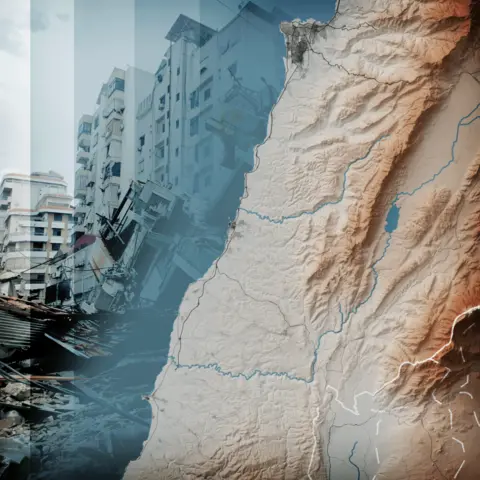 BBC
BBCIsrael has invaded southern Lebanon in a dramatic escalation of its conflict with Hezbollah.
The Israeli ground operation began on Monday night, days after an air strike killed the leader of the Iran-backed armed group, Hassan Nasrallah.
Hezbollah has fired hundreds of rockets into northern Israel as Lebanon has endured two weeks of aerial bombardment that Lebanese authorities say has killed more than 1,000 people and forced up to a million to flee their homes.
Israel has a decades-long history of conflict with Hezbollah but the war in Gaza has sparked almost a year of deadly cross-border fighting between them.
We will be continually updating maps in this page to help explain the conflict.
Where is Lebanon?
Lebanon is a small country with a population of about 5.5 million people, which borders Syria to the north and east, Israel to the south, and the Mediterranean Sea to the west. It is about 170km (105 miles) away from Cyprus.
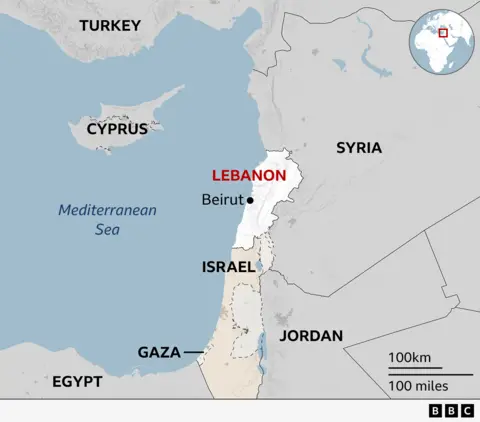
Where is the Israeli advance?
The Israel Defense Forces (IDF) says it is carrying out “limited, localised, and targeted ground raids” in southern Lebanon to dismantle what it calls Hezbollah’s “terrorist infrastructure”.
On Wednesday, the second full day of their invasion into Lebanon, Israeli troops encountered Hezbollah fighters for the first time, says the BBC’s Nick Beake who is in northern Israel.
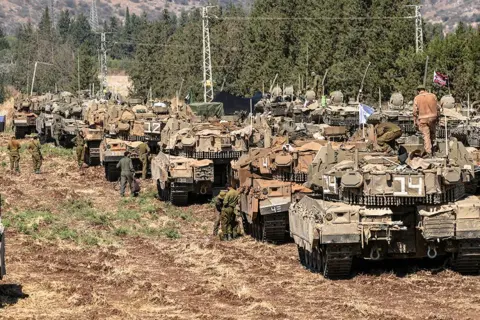 Reuters
ReutersThe IDF said soldiers had “eliminated terrorists and dismantled terrorist infrastructure through precision-guided munitions and close-range engagements” in several southern Lebanese areas.
Later, the IDF announced that eight troops had been killed in action. Six were reportedly ambushed by Hezbollah fighters and another two were killed by mortar fire.
Hezbollah said its fighters had fired anti-tank missiles at Israeli commandos during clashes in one border village. It also claimed that other troops were targeted with explosives and gunfire on the outskirts of Kafr Kila, that three Israeli Merkava tanks were destroyed by missiles near Maroun al-Ras, and that there were also clashes in Adaisseh and Yaroun.
A ground operation in southern Lebanon comes with many risks for Israeli forces. Unlike the flat coastal plains of Gaza, southern Lebanon has rolling hills and some mountainous terrain that makes it difficult for tanks to move easily without fear of being ambushed.
Hezbollah is also thought to have a network of tunnels in the region, with the group having been preparing for another full-scale conflict with Israel since the 34-day war in 2006.

The IDF has ordered people living in some villages in southern Lebanon to evacuate, telling those remaining to leave their homes and “immediately head to the north of the Awali River” – which meets the coast about 50km (30 miles) from the border with Israel.
Lebanese civilians have also been warned by the IDF not to use vehicles to travel south across the Litani River, located about 30km (20 miles) north of the border.
About a million people lived in southern Lebanon before the conflict escalated almost a year ago. Tens of thousands have been fleeing north since Israeli air strikes in the region intensified in late September.
Israeli air defences were also in action again on Wednesday, a day after they repelled the vast majority of the more than 180 ballistic missiles launched by Iran towards Israel on Tuesday night in retaliation for the strike that killed Hassan Nasrallah as well as a top Iranian commander.
More than 240 rockets were fired from southern Lebanon towards northern Israel throughout the day, according to the IDF.
What have Israel’s air strikes targeted?
Israel’s invasion of southern Lebanon came after nearly two weeks of intense air strikes targeting Hezbollah’s strongholds across the country.
Southern Lebanon has been most affected, with strikes also targeting the eastern Bekaa Valley and in the southern suburbs of Beirut.
Israel says it is hitting Hezbollah sites, including weapons stores and ammunition dumps, but Lebanese officials say more than 100 women and children have been killed.
For Lebanese civilians trying to flee from southern Lebanon, the main route north is the coastal road that runs the length of the country – but areas along that route have been targeted by air strikes in recent days.
The majority of the rockets recently fired by Hezbollah have targeted northern areas of Israel. But some rockets have reached further south and damaged homes near the coastal city of Haifa.
The Israeli strikes on Beirut have focused on Dahieh, a southern suburb which is a densely populated area that is home to thousands of civilians and has a strong Hezbollah presence.
What could happen next?
Israel is now engaged in hostilities with armed forces and non-state armed groups in several countries in the region, including Iran, Syria and Iran-backed groups operating in Lebanon, Gaza, Iraq, Syria and Yemen.
Iran’s ballistic missile attack on Israel was the latest major escalation.
What happens next is unclear, but Israel has vowed to respond, with Prime Minister Benjamin Netanyahu describing the attack as “a big mistake” that Iran “will pay for”.
